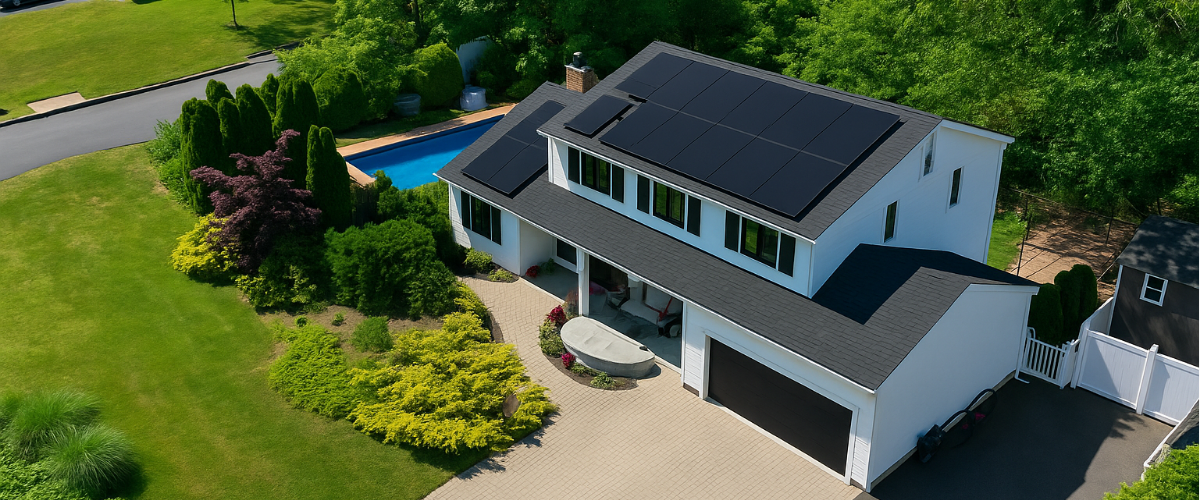How Big Are Solar Panels? What You Should Know

Solar and Roofing Advisor
Wondering if solar panels will fit on your roof? Learn the average solar panel size, dimensions, and how many you need for your California home.

When you think about going solar, one of the first questions that often comes up is: how big are solar panels, and will they fit on my roof? While solar energy is an incredible investment, panel size and system layout play a huge role in determining how much clean power your home can generate.
At US Power, we make sure every installation is tailored to your roof and your energy needs. Let’s break down the dimensions, configurations, and what they mean for your home.
Standard Residential Solar Panel Sizes
Most residential solar panels are built with silicon photovoltaic (PV) cells arranged in a grid. While exact dimensions can vary by brand and model, here are the most common panel sizes you’ll find for homes:
- 60-cell panels
- Roughly 65 inches x 39 inches (about 5.5 ft x 3.25 ft)
- Lightweight and manageable for most rooftops
- The most common option for residential installations
- 72-cell panels
- About 77 inches x 39 inches (6.4 ft x 3.25 ft)
- Slightly larger, generating more electricity per panel
- A good choice if you have plenty of roof space and want fewer panels
- 96-cell panels
- Approximately 62 x 41 inches
- Typically used in commercial or utility projects due to their size and weight
For most Southern California homeowners, 60-cell and 72-cell panels strike the best balance between efficiency, handling, and rooftop fit.
How Many Panels Do You Need?
Panel size matters because it impacts how many units can fit on your roof and how much energy they’ll generate.
To estimate how many panels you need:
- Look at your electricity bill. Find your monthly usage in kWh (kilowatt-hours).
- Divide by daily sunlight. Southern California averages around 5–6 hours of strong sunlight per day.
- Match with panel wattage. Panels typically range from 350W to 450W each.
For example, if your home uses 900 kWh per month, you’ll need a system that generates about 30 kWh per day. With 6 hours of sunlight, that’s 5 kW of solar capacity. Using 400W panels, that means about 12–14 panels are required.
On average, most California homes need 18–23 panels, which takes up roughly 375–425 square feet of roof space.
Why Panel Size and Layout Matter
Panel size isn’t just about physical dimensions—it affects the efficiency, aesthetics, and long-term value of your system.
- Roof fit: Larger panels may reduce installation costs, but smaller panels fit better on complex rooflines.
- System efficiency: Bigger doesn’t always mean better—high-efficiency smaller panels may outperform larger, lower-grade ones.
- Maintenance: Fewer, larger panels can simplify wiring and upkeep, while more, smaller ones provide flexibility.
- Home value: A well-designed system not only saves money but also boosts your home’s resale appeal.
At US Power, we evaluate every home holistically—roof size, shading, energy goals—to create a system that maximizes returns.
Takeaway: Choosing the Right Panels for Your Home
For most Southern California homeowners, standard 60-cell or 72-cell solar panels are the perfect fit. The real key isn’t just panel size—it’s how your system is designed to meet your specific energy needs and maximize your roof’s potential.
Ready for a Custom Solar Layout?
At US Power, we don’t believe in one-size-fits-all solar. Our team designs systems that fit your roof, your budget, and your lifestyle—so you get the most out of your investment.
Contact us today for a FREE CONSULTATION and see how the right solar panels can power your Southern California home for decades to come.
Artículos relacionados
Nuestros blogs relacionados
Discover why US Power homeowners prefer QCells for long-lasting solar energy.
Experience faster, high-quality solar installations backed by QCells reliability.
Buying factory-direct QCells solar panels maximizes savings and ensures top quality.
Nuestros socios de marcas de energía solar y techos








Empoderamos a las comunidades y las empresas para que aprovechen las energías limpias y renovables energía solar soluciones que impulsan el crecimiento sostenible.
Derechos de autor © 2025 US POWER | Energía solar y techosUS Power - Axia by QCells. All Rights Reserved.
La privacidad es importante para nosotros, por lo que tiene la opción de deshabilitar ciertos tipos de almacenamiento que pueden no ser necesarios para el funcionamiento básico del sitio web. El bloqueo de categorías puede afectar a su experiencia en el sitio web.
Imprescindible
Estos elementos son necesarios para habilitar la funcionalidad básica del sitio web.
Personalización
Estos elementos permiten que el sitio web recuerde las elecciones que ha realizado (como el nombre de usuario, el idioma o la región en la que se encuentra) y proporcionan funciones mejoradas y más personales.
Mercadeo
Estos artículos se utilizan para ofrecer publicidad que sea más relevante para usted y sus intereses.
Analítica
Estos elementos ayudan al operador del sitio web a comprender cómo funciona su sitio web, cómo interactúan los visitantes con el sitio y si puede haber problemas técnicos.
Nosotros y nuestros socios externos utilizamos cookies y otras tecnologías para mejorar y rastrear su experiencia en este sitio, realizar análisis y personalizar el marketing para usted. Al usar el sitio, aceptas que usemos estas tecnologías, incluido el registro y el monitoreo de tus interacciones con el sitio.
¡Obtenga una estimación solar instantánea usando el satélite!










